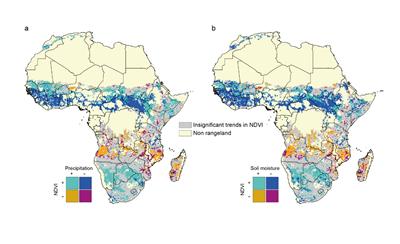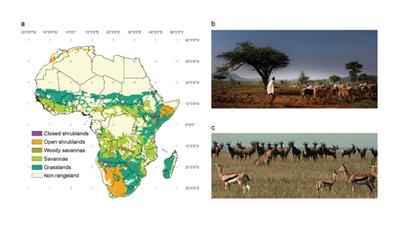Large-scale greening and changes in productivity of African drylands, study shows

The African drylands (Figure 1) is inhabited by close to 270 million people whose main source of livelihood is subsistence pastoral livestock grazing, which rely on the availability of good quality pasture. Climate change is expected to result in significant changes to the characteristics and function of these drylands. Evaluating the impacts of climate change on vegetation composition and structure of African drylands is crucial in developing strategies for sustaining the livelihoods of its inhabitants.
A team of researchers from the University of Southampton and the University of Copenhagen used an ensemble of satellite remote sensing data, dynamic global vegetation model, and a diagnostic model to assess the relationship between climate change and vegetation vigour, structure, and function in the African drylands. Findings published in two new articles in Elsevier Global and Planetary Change Journal revealed large-scale greening trends (i.e., more vegetation) throughout the African drylands with a large proportion of these resulting from a significant increase in (unpalatable) woody species. Even though the increase in woody vegetation may be useful in mitigating climate change through increased capture of carbon dioxide, it will result in the reduction of pasture, the main resource sustaining the key livelihood activity (i.e., pastoralism) of the local inhabitants in these drylands.

Figure 1: Approximate extent (ca. 11,000,000 km2) of the African drylands as indicated per main land cover types (a). Herdsman and cattle in drylands of Ethiopia (b) and Kenya wildlife-rich drylands (c). Photo credit: International Livestock Research Institute. (Source: Global and Planetary Change)
The first study (https://doi.org/10.1016/j.gloplacha.2021.103516) by combining more than 30 years of Earth Observation data and a Dynamic Global Vegetation Model (DGVM) simulations highlighted the role of long-term climate change in shaping changes in the vegetation cover across African drylands. This research showed that majority of African drylands experienced vegetation greening (increase in vegetation) between 1980 and 2015. Additionally, the study was able to identify regions where vegetation changes were largely controlled by climate (i.e., in Western Sahel, Chad and Southern Africa) and areas where non-climatic factors (e.g., land use change, fire, urbanisation) were the dominant drivers of vegetation change (i.e., in West Africa, South Sudan, Angola and Mozambique) (Figure 2).

Figure 2: Co-relationships between trends in NDVI and precipitation (a) and between trends in NDVI and soil moisture (b). NDVI increased together with precipitation and soil moisture across parts of western Sahel (southern Mauritania, Senegal, Mali), Chad, and southern Africa (Namibia, Botswana, and South Africa) (turquoise), while no major regions of browning due to a decrease in precipitation and soil moisture were observed (purple). Changes in NDVI resulted unrelated to changes in water availability mostly in West Africa (Ghana, Guinea, Ivory Coast) and South Sudan (greening; blue), and Angola and Mozambique (browning; orange). (Image Credit: Global and Planetary Change)
The second study (https://doi.org/10.1016/j.gloplacha.2021.103524) investigated the impacts of the changes in vegetation cover on the African dryland’s carbon and water cycle. The results revealed that the vegetation greening resulted in an 18% increase in gross primary productivity (a measure of carbon dioxide capture by plants), which imply that the region could become an important contributor to the global carbon sink. Additionally, the vegetation greening led to alteration of the components contributing to the water cycle. For example, there was more than 20% increase in evapotranspiration, which has the potential of altering water availability in the region.
Prof. Jadu Dash, Professor of Remote Sensing at the University of Southampton and coordinator of both analyses, said that “Both studies provide a comprehensive understanding of vegetation changes in African Drylands which are facing both climatic and anthropogenic pressure. The spatial distribution of the changes in vegetation cover and its drivers is crucial information to develop land management policy while quantifying the impact of such changes on key ecosystem processes shows their importance in the global carbon and water cycle.”
Dr Booker Ogutu, Lecturer in Remote Sensing at the University of Southampton added that “Long term satellite data offers an opportunity to study the impacts of climate change on fragile, but important ecosystems such as drylands. This study shows that drylands undergoing ecosystem change, coupled with climate change, may in future become important contributors to the global carbon and water cycle and hence could play a key role in future global warming and climate change mitigation strategies.”
Dr Francesco D’Adamo added that “Even though the two studies showed the potential of using long term Earth Observation data and models to evaluate impacts of climate change on vegetation composition in African drylands, there is still a gap in understanding the mechanisms that drive the changes in vegetation composition in these drylands. For example, it is not currently understood what factors enable woody vegetation encroachment to dominate the vegetation greening in these drylands in comparison to other vegetation types.”
- D’Adamo, F., Ogutu, B., Brandt, M., Schurgers, G., & Dash, J. (2021). Climatic and non-climatic vegetation cover changes in the rangelands of Africa. Global and Planetary Change, 202, 103516. https://doi.org/10.1016/j.gloplacha.2021.103516
- Ogutu, B. O., D’Adamo, F., & Dash, J. (2021). Impact of vegetation greening on carbon and water cycle in the African Sahel-Sudano-Guinean region. Global and Planetary Change, 202, 103524. https://doi.org/10.1016/j.gloplacha.2021.103524